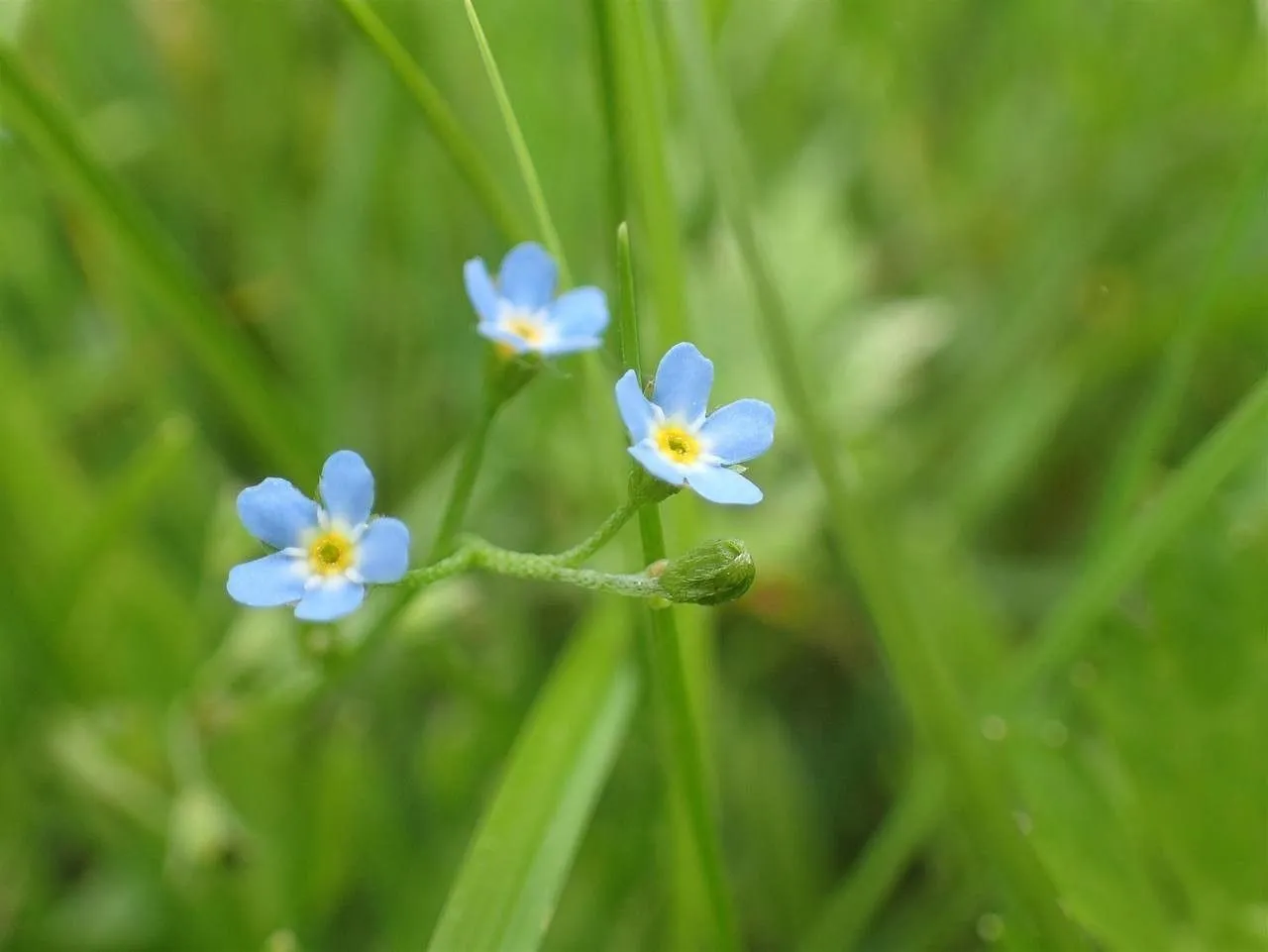
Author: Lehm.
Bibliography: Pl. Asperif. nucif. 83. 1818
Year: 1818
Status: accepted
Rank: species
Genus: Myosotis
Vegetable: False
Observations: Subarctic & Temp. Northern Hemisphere
The Tufted Forget-me-not, known scientifically as Myosotis laxa, is a charming member of the Boraginaceae family. First described by Lehm. in his 1818 work, “Pl. Asperif. nucif. 83,” this delicate flowering plant can be found throughout the subarctic and temperate regions of the Northern Hemisphere.
Renowned for its clusters of small, sky-blue flowers, the Tufted Forget-me-not thrives in moist environments, often gracing the edges of streams, ponds, and meadows with its gentle beauty. Its blooms, which typically appear in late spring to early summer, create a carpet of color that is both striking and serene.
Despite its fragile appearance, Myosotis laxa is a resilient species, capable of enduring the cooler climates of its native habitats. Its leaves are narrow and slightly hairy, forming a basal rosette that gives way to the flowering stems. The tiny, five-petaled flowers are not only aesthetically pleasing but also attract a variety of pollinators, playing a vital role in the local ecosystem.
The Tufted Forget-me-not is more than just a beautiful wildflower; it serves as a symbol of remembrance and enduring affection in various cultures. Gardeners and nature enthusiasts alike value this plant for its low-maintenance care and ability to thrive in wet, shaded areas where few other plants can flourish.
In summary, the Tufted Forget-me-not (Myosotis laxa) is a testament to the subtle yet profound beauty of nature. Its presence in the Northern Hemisphere’s subarctic and temperate zones enriches the landscape, offering both ecological benefits and a visual reminder of nature’s delicate wonders.
Eng: bay forget-me-not, tufted forget-me-not, small forget-me-not, small-flowered forget-me-not
Deu: rasen-vergissmeinnicht, rasiges vergißmeinicht, schlaffes vergissmeinnicht
Dan: sump-forglemmigej
Fin: rantalemmikki
Swe: rantalemmikki, sumpförgätmigej
Nob: sumpforglemmegei
Nno: sumpminneblom
Nld: zompvergeet-mij-nietje
Fra: myosotis laxiflore, myosotis cespiteux, myosotis à petite fleur
Ita: nontiscordardimè dei canneti
Cym: sgorpionllys siobynnog, ysgorpionllys lleiaf, ysgorpionllys siobynnog
En: Tufted forget-me-not, Bay forget-me-not, Small-flower forget-me-not, Small forget-me-not, Small-flowered forget-me-not
Ar: أذن الفأر المتهدل
Da: Sump-Forglemmigej
Nl: Zompvergeet-mij-nietje
Et: Balti lõosilm
Fi: Rantalemmikki
Fr: Myosotis Cespiteux, Myosotis laxiflore, Myosotis à petite fleur
De: Rasen-Vergissmeinnicht, Rasiges Vergißmeinicht, Schlaffes Vergissmeinnicht
It: Nontiscordardimè dei Canneti
Ko: 개꽃마리
Nb: Sumpforglemmegei
Nn: Sumpminneblom
Ru: Незабудка балтийская
Sv: Sumpförgätmigej, Rantalemmikki
Uk: Незабудка розлога
Cy: Sgorpionllys siobynnog, Ysgorpionllys Lleiaf, Ysgorpionllys Siobynnog
Taken May 18, 2017 by Yoan MARTIN (cc-by-sa)
Taken May 18, 2017 by Yoan MARTIN (cc-by-sa)
Taken Jul 3, 2018 by Miguel A. C. (cc-by-sa)
Taken May 18, 2017 by Yoan MARTIN (cc-by-sa)
Taken May 18, 2017 by Yoan MARTIN (cc-by-sa)
Taken Jun 21, 2022 by Robin Lewando (cc-by-sa)
Taken Apr 23, 2020 by Sabina Hartmann (cc-by-sa)
Taken Aug 22, 2020 by anne favry (cc-by-sa)
Taken May 23, 2020 by Heather Lewis (cc-by-sa)
Taken Jul 4, 2021 by Анна Шульгина (cc-by-sa)
Taken Jul 13, 2020 by k sch (cc-by-sa)
Taken May 18, 2017 by Yoan MARTIN (cc-by-sa)
Taken Jul 11, 2021 by Darren Giddins (cc-by-sa)
Taken Sep 8, 2022 by jvanbuul (cc-by-sa)
Taken Aug 22, 2020 by anne favry (cc-by-sa)
Taken May 18, 2017 by Yoan MARTIN (cc-by-sa)
Taken Aug 15, 2018 by Photoflora – Jean-Luc TASSET (©)
Taken Aug 15, 2018 by Photoflora – Jean-Luc TASSET (©)
Taken Jan 1, 1800 by Tela Botanica − Thierry Pernot (cc-by-sa)
Taken Aug 15, 2010 by Photoflora – Benoit BOCK (©)
Taken Jan 1, 1970 by Photoflora – L’Abbé COSTE (©)
Taken Jul 15, 2018 by Photoflora – Jean-Luc TASSET (©)
Taken Jan 1, 1900 by EOL − Encyclopedia of Life (cc-by-nc-sa)
Taken Jan 1, 1900 by EOL − Encyclopedia of Life (cc-by-nc-sa)
© copyright of the Board of Trustees of the Royal Botanic Gardens, Kew.
© copyright of the Board of Trustees of the Royal Botanic Gardens, Kew.
© copyright of the Board of Trustees of the Royal Botanic Gardens, Kew.
Growth habit: Forb/herb
Ph maximum: 7.0
Ph minimum: 6.5
Light: 8
Atmospheric humidity: 8
Soil nutriments: 5
Soil salinity: 1
Family: Myrtaceae Author: (F.Muell.) K.D.Hill & L.A.S.Johnson Bibliography: Telopea 6: 402 (1995) Year: 1995 Status:…
Family: Rubiaceae Author: Pierre ex A.Froehner Bibliography: Notizbl. Bot. Gart. Berlin-Dahlem 1: 237 (1897) Year:…
Family: Sapindaceae Author: Koidz. Bibliography: J. Coll. Sci. Imp. Univ. Tokyo 32(1): 38 (1911) Year:…
Family: Asteraceae Author: A.Gray Bibliography: Pacif. Railr. Rep.: 107 (1857) Year: 1857 Status: accepted Rank:…
Family: Fabaceae Author: Medik. Bibliography: Vorles. Churpfälz. Phys.-Ökon. Ges. 2: 398 (1787) Year: 1787 Status:…
Family: Aspleniaceae Author: (Cav.) Alston Bibliography: Bull. Misc. Inform. Kew 1932: 309 (1932) Year: 1932…